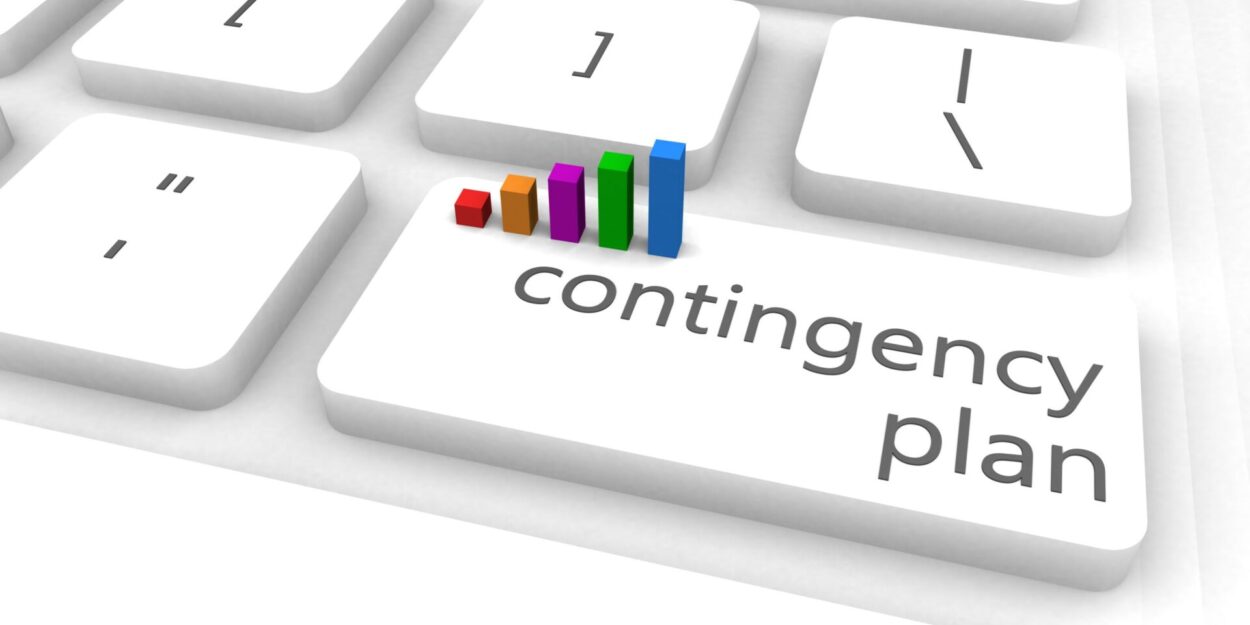
For some businesses, the COVID-19 pandemic has been a struggle. Others are barely hanging on by a thread. The sudden, unforeseen lack of demand for their products or services forced many businesses to pivot their models and rely on sales contingency plans to adjust their sales processes to digital, contactless environments.
Businesses that were too focused on one customer type or business vertical were the hardest hit by the pandemic — as were those that receive a large percentage of their revenue from a limited number of customers. They had too many of their eggs in one basket. Other struggling businesses were overly reliant on sales from existing customers and hadn’t developed the proficiency to gain new customers. Perhaps they had the wrong sales personnel, compensation plans, tactics, or key performance indicators (KPIs), which made it difficult to find new revenue when their existing customers were buying less.
Many businesses also rushed to the “shiny penny” opportunities presented by the pandemic. They immediately began to manufacture or broker pandemic-related products, such as masks and sanitizer. The problem, though, was that too many companies did that at once — and it didn’t turn out to be a long-term solution. Other companies focused too much on reducing costs, but they didn’t invest in areas they would need to pivot toward when stability returned. Reducing costs isn’t a bad idea by any means, but it’s important to recognize that some investment will be necessary if you ever need to pivot to a new model.
The few companies that came out ahead did things differently. They quickly connected with customers, suppliers, and partners; they proactively managed expectations with their constituents regarding pricing, inventory, and delivery options. Customers appreciated the quick and constant communication, helping those companies retain a higher level of their existing customer base after their sales recovery.
In addition to impacting external groups, this superior communication affected internal teams. Normal sales practices weren’t as effective during the crisis, which meant that regular communication to empower sales teams was critical. Sales professionals needed clear, direct guidance from their leaders. They needed training on new skills for digital selling to help them remain successful in their roles in a drastically altered sales environment.
In many cases, these companies were successful because they already had sales contingency plans in place; they had proactively created clear-cut processes and procedures to address unexpected shifts in their business models. Companies without plans scrambled to transform their sales departments overnight, retraining their people to sell virtually while sprinting to make the necessary operational adjustments.
Sales Challenges in a New Era
COVID-19 has created plenty of eye-opening moments in terms of its impact on sales operations. In many ways, the crisis brought to light major problems and deficits already latent in the sales industry.
For one, COVID-19 dramatically impacted customer demand for many companies — some positively and some negatively. The crisis basically happened overnight, which meant it wasn’t easy to predict and plan for. Because of this, the pandemic highlighted how few companies had contingency sales plans in place. This is one of the many reasons the sales industry has historically struggled to ride out massive disruptions like health crises and recessions.
As the country begins to reopen, it’s time for companies to transform their sales operations from a mindset focused on enduring the COVID-19 crisis into one that’s able to survive a recession and emerge stronger on the other side. What lessons can businesses take from these experiences to help build their sales plans for 2021?
In general, a strong contingency plan includes two main things: adapting operations and boosting resiliency. Businesses must consider how to reengage their employees, especially after the uncertainty created by any downsizing or furloughs. They also must create forward-looking ways to fix broken supply chains, get more agile in their operations and cost base, decrease operational risk, and strengthen their communications processes.
For your sales organization to thrive in a virtual work environment, you’ll need to invest time and resources in the appropriate tools. If you’re trying to skate by with a mediocre videoconferencing platform for in-depth product demos, for instance, you should consider investing in a high-quality solution that delivers a premier experience — and doesn’t risk alienating customers.
If you’re not sure where to get started, here are the three key tools you’ll need to set up your organization for successful virtual selling:
Tool No. 1: Data
While it could be argued that selling is part art and science (and we agree), sales forecasting is mostly science. Sure, you need to alter individual forecasts to take out any optimism or pessimism and focus purely on reality, but sales forecasts should concentrate almost entirely on predictive data. When data in sales is altered by external factors (like those we’ve seen in 2020), that predictive data no longer paints an accurate picture.
Imagine a professional baseball player who has a consistent career batting over .300, with 30-plus HRs and 100-plus RBIs. Let’s say he experienced a serious injury and was out most of last season. Could you rely on his previously consistent performance to predict how he’ll be when he returns? Probably not. External factors have likely impacted his consistency.
What should you expect from him going forward? You won’t know until he starts playing again. You may be able to garner some leading sales performance indicators by watching him participate in batting practice, hit off of his team’s own pitchers, or adjust to a new bat speed. However, you ultimately won’t get a clear look at his performance until a month or so into the season.
The same principles apply when evaluating your organization’s ability to collect, interpret, and implement data.
Start at the baseline we discussed. How would you rate your sales team’s understanding of data — including key sales metrics? Do they understand the difference between lead and lag indicators for sales? The more quickly you can figure out your new normal, the better you can determine which sales performance indicators are predictable in this new environment. This information will help make your sales forecast more accurate.
Selecting the metrics that help you know where you will finish in the future is key. Sales forecasting should be based on key sales metrics and key performance indicators (KPIs), also known as leading indicators. Most businesses mistakenly look at lagging indicators (e.g., sales that have already happened, sales by product, sales by channel, etc.). Those lagging indicators can’t be changed because they have already taken place. They are more appropriate for confirming trends in industries and the economy than predicting what’s next.
Too often, organizations don’t understand the “why” behind good or bad results. To dig deeper, your team should ask itself some important questions: “Why do customers buy from us?” “Why don’t they?” “Why do they need a demo before buying?” “Why didn’t we earn the right to have a second meeting?”
To answer these questions, you must have the right key sales metrics to measure your sales performance, observe trends, and track execution. Without using sales performance indicators, you’re making decisions based on your opinion or gut feelings rather than real data. Imagine having your revenue decrease significantly due to a crisis, only to make a big mistake by taking your sales organization in a new direction that was based on opinions instead of key sales metrics. A poor decision like this — on top of already decreasing sales — could put your company out of business.
Tool No. 2: A Clearly-Defined Sales Strategy
Emergency sales strategies are typically put in place to help you survive rather than thrive. They are short-term plans by their very nature, but you eventually need a long-term strategy. That’s why emergency sales strategies implemented after COVID-19 will not be enough in the long run.
The onus is on sales leaders to create a goal-focused, mission-oriented, well-communicated sales plan to position their sales operations for long-term success and fortify them against future disruptions. This type of well-defined sales strategy keeps everyone in alignment on goals and how to achieve them. This plan helps everyone work toward a common target, and it also lets them know when they’ve hit that goal — or missed the mark. And when the whole team is working from the same plan, it’s far easier to pivot everyone at once.
To define your sales strategy, start by analyzing your current situation. You need to develop a clear, realistic baseline of the company’s current sales position before you can map out where you want to go. Then, build your crisis sales recovery plan with predetermined “what if scenarios” — key components of a sales strategy — so you can move quickly in case the crisis shifts or becomes more severe.
Now is the time to stress test performance results against your different sales scenarios using sales forecasting data science. For example, if your entire sales team had to cut out all in-person meetings tomorrow, how equipped would it be to adapt? How would this affect your sales projections and metrics? What would it take to prepare your team for that situation?
Finally, define your “new normal.” Define your sales strategy and scenarios for your company given what you’ve learned from the current situation. Use trigger points to determine what actions are needed at certain checkpoints before the circumstances clearly present themselves, which should help you stay proactive. For example, do you need to reduce your dependency on a few large clients? If so, your team will need to acquire new clients. Do you have too much revenue attached to one product or market segment? If so, increase your scope to reduce the risk. Taking these actions now will minimize your future risk.
Tool No. 3: Empowered Sales Personnel
The sales-first mindset we’ve seen implemented in the aftermath of COVID-19 is neither sufficient for a long-term strategy — nor will it retain the best sales personnel once the crisis ends. It might help you win a few battles, but you’ll eventually lose the war.
Think of it this way: Perhaps you’re heavily discounting your product to gain new sales and hit quarterly goals. While you might nail the goal and meet the forecast, you’re also training your customers to expect these discounts in the future. This eventually will lower your margin and future revenue, making it harder to achieve future goals once you get past the current crisis.
If you’re wondering how to enable sales, a better place to focus your sales strategy is on a well-constructed sales compensation plan. This plan should demonstrate that you acknowledge the sales challenges your team faces and are willing to compensate them for their hard work. A good compensation plan will not only attract and retain employees, but it will ultimately attract and retain the best performers.
The best sales compensation plans come down to alignment. What your organization wants to achieve must be reflected in how you compensate sales leaders, which should be reflected in how the sales team is compensated. Note that this plan should change every year based on the current sales environment, the team’s performance, and the state of your company. Ultimately, your compensation plan should be a win-win scenario for everyone involved.
Beyond addressing compensation, you’ll want to ensure you have a great sales culture and stellar communication among your sales team. A crisis should bring everyone together rather than push them apart. Good communication starts with setting clear expectations — and making sure that those goals are reasonable. A sales team knows what is reasonable, what is a stretch, and what is definitely attainable. Set goals that are too high, and you could lose your employees’ attention and focus. If you do this, your best performers won’t hesitate to go to competitors that don’t set unrealistic expectations (and tie their compensation to it).
Once you’ve made sure you’re paying your sales team appropriately and communicating clearly, ask yourself whether you are truly enabling them to be successful. In particular, focus on the digital resources you are providing them. For example, could you implement virtual buying personas and scenario-based selling practices to better train your salespeople? How easy is it for them to display company branding in meetings (e.g., virtual backgrounds, screen savers, etc.)? Have you trained your sales team on how to adjust its meeting style for digital environments (e.g., demonstrating value more quickly and following up with relevant supplemental material)? These are pertinent questions to consider.
The COVID-19 pandemic has touched virtually every business in one way or another. The clear winners as the economy continues to rebound are the companies that respond quickly, communicate with their customers, empower their sales teams, and leverage available tools to create long-term strategies. The more quickly you can lead your company with a similar strategy — one that transitions sales operations from worrying about enduring the pandemic into a mindset that’s primed to emerge stronger on the other side — the more successful you will be in the long term.




